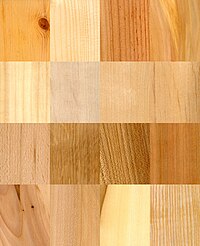
Photo from wikipedia
Stored water in inner tissues influences the plant water economy, which might be particularly relevant for trees facing increasing dry conditions due to climate change. We studied the water storages… Click to show full abstract
Stored water in inner tissues influences the plant water economy, which might be particularly relevant for trees facing increasing dry conditions due to climate change. We studied the water storages in the inner bark and the sapwood of Araucaria araucana. This species has an extremely thick inner bark and thus it can be used as a model system to assess the impact of internal water storage on plant water balance. Specifically, we analyzed the water circulation pathways in and out of the elastic water storages by using simultaneously frequency domain moisture sensors and dendrometers inserted in the inner bark and in the sapwood, and sap flow determinations during the dry season. The daily patterns of water content and expansion and contraction of the stem tissues were similar to the sap flow pattern. The whole-stem water content and diameter increased in the morning and decreased in the afternoon, contrary to typical pattern observed in most tree species. An osmotic gradient favoring the water influx from sapwood to inner bark was observed in the morning. There were no lags in the onset of sap flow between different stem heights at the time that recharge of reservoirs occurred. Sap flow at 6 m height was higher than basal sap flow in the afternoon, when the sapwood water content started to decline followed by the water content of the inner bark. Inner bark and sapwood contributed with 5 to 11% to total daily transpiration allowing the maintenance of high water potentials in the dry season. Our results suggest that the stored water in the stems, the atypical dynamic of recharge and discharge of water from reservoirs and the high tissue capacitance may make an important contribution to the survival of A. Araucana during drought periods by maintaining the water balance.
Journal Title: Tree physiology
Year Published: 2022
Link to full text (if available)
Share on Social Media: Sign Up to like & get
recommendations!